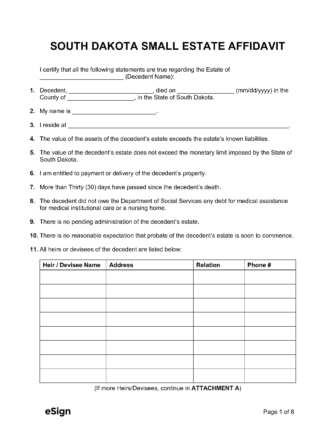A South Dakota small estate affidavit aids the transfer of personal property of a deceased individual (the “decedent”) to their successors without formal probate proceedings. Any beneficiary entitled to the decedent’s property may fill out this affidavit and use it to collect the assets from its current custodians. This affidavit may not be used to transfer a house, land, or any other real property.
To transfer ownership of a motor vehicle, the affiant will need to complete a Succession Affidavit and file it with the Department of Revenue Motor Vehicle Division.
Laws
- Statute: § 29A-3-1201 & 29A-3-1202
- Maximum Estate Value (§ 29A-3-1201(a)(1)): $100,000
- Mandatory Waiting Period (§ 29A-3-1201(a)(2)): Thirty (30) days
- Where to File: No filing requirements.
How to File (2 Steps)
Step 1 – Requirements
Any successor entitled to the decedent’s property may use this affidavit as long as the following is true:
- At least thirty (30) days have elapsed since the decedent’s death.
- The total value of the estate is no greater than $100,000.
- No application is pending for the appointment of a personal representative.
- The decedent did not owe medical debts to the Department of Social Services.
- The claiming successor is entitled to payment or delivery of the property.
Step 2 – Complete Affidavit
The successor may complete and sign the affidavit if the aforementioned requirements have been met. The document must be notarized in order to be valid. Upon completion, the successor will accept responsibility for paying outstanding liens, funeral expenses, and creditors, and distributing the remaining assets to the rightful heirs in accordance with the will or intestate succession laws.
Step 3 – Distribute Assets
Once the affidavit has been completed and notarized, the successor may use the document to collect the payment and property of the decedent from the current custodians. In accordance with 29A-3-1202(b), any refusal to hand over the property upon the presentation of the affidavit enables the successor to attempt to recover the assets through legal proceedings.

